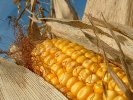August 16, 2010

"Most cornfields in northeast Iowa look very good right now," says Brian Lang, Iowa State University Extension area agronomist at Decorah. There are some fields where corn is showing some "tipping back" of the kernels at the ends of the ears. That is, the kernels aren't filling out completely to the ends of the ear tips.
"Corn is showing some 'tipping back' of the kernels at the ends of the ears, which is normal," says Lang. "If there is no 'tipping back,' that usually means that a higher population would have resulted in higher yield. Some corn is showing a bit more 'tipping back' than we like to see, however."
Additional stress causes corn tipping back and premature denting
Once the ears reach the R2 (blister) stage, if the plant is stressed and starts to 'become less optimistic,' kernel abortion will occur from the tip back, he explains. Kernel abortion will continue to the end of R3 (milk) stage if stress is present. Once the plants are into the R4 (dough) stage, the only adjustment the plant can make is to the kernel size. Early denting would be an indicator that the plants are continuing to be 'less optimistic' and are adjusting kernel size down, which will result in lighter kernels at harvest.
Where are we seeing some stress in cornfields this summer? The five most common areas of fields and causes of stress include: 1) Areas of fields where soils remained saturated longer, thus leading to loss of nitrogen. 2) The extended hot weather tends to speed maturation and cost us some opportunity to fill grain to its maximum. 3) Possible loss of significant photosynthetic leaf area from fungi or bacterial infestation. 4) Rootworm injury, reducing root mass and causing some lodging. 5) Early season root rots that basically have held back normal plant development from the start of the season.
More white mold disease in beans showing up in northeast Iowa
More white mold disease in soybeans is showing up all across northeast Iowa, says Lang. Most of the soybean crop is now in the R5 growth stage and well past a treatable window with fungicides. By the time you can see white mold leaf symptoms, the plants were infected weeks earlier. Any fungicide applications would have needed to be applied weeks earlier, which is why labels state applications at R1 to R3 stage. A review of the basics in white mold management is at extension.agron.iastate.edu/soybean/whitemold.html.
More reports of Sudden Death Syndrome in soybeans statewide
Sudden Death Syndrome, a devastating disease of soybeans, is showing up in many fields in most areas of the state this August. "I am seeing and receiving many more reports of SDS in soybeans," says Lang. "The climate in May (cold, wet) provided very favorable conditions for SDS infection to get into the soybean seedlings. The fungus continued to develop in the plant during the season, and typically by early August toxins produced by the fungus impact soybean leaves."
This causes the interveinal chlorosis (yellowing between the leaf veins) and eventually the leaves drop off the soybean plant. The petioles will remain intact and erect on the soybean plants. "These symptoms are sometimes confused with brown stem rot, another disease," says Lang. "The leaf symptoms are similar, but by slicing open the stem lengthwise you can check the pith; the material inside the stem. If the pitch is brown, the disease is brown stem rot. If the pitch is white, the disease is SDS. For ID tips, go to
www.ipm.iastate.edu/ipm/icm/2007/3-26/bsr_vs_sds.html
What you can do about SDS? Here are basic management tips
1) SDS is a root rot, not a leaf disease, says Lang. No foliar fungicides will help. So don't bother trying to apply a foliar fungicide to combat SDS.
2) None of the currently available fungicide seed treatments are effective on SDS. Research on this continues, however.
3) Note the problem locations in a field and the soybean varieties planted. The best single control measure is selecting highly-tolerant varieties to plant, the next time you plant beans in that field.
4) A corn-soybean crop rotation does not reduce the level of SDS present in the soil. However, a multiyear hay rotation could.
You May Also Like




